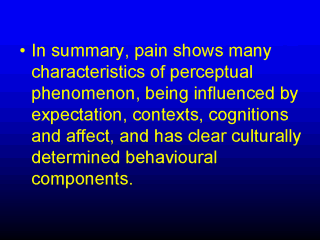| front |1 |2 |3 |4 |5 |6 |7 |8 |9 |10 |11 |12 |13 |14 |15 |16 |17 |18 |19 |20 |21 |22 |23 |24 |review |
 |
The evidence presented in this
lecture indicates that, the obvious physiological basis for pain sensation aside, pain
experience itself is subject to a wide ranging influences. This dictates that we need to
consider pain as spectrum of perceptual phenomena, which often has a physical component
and sometimes a psychological origin.. At the other end of the spectrum is the experience
of what has been called psychological pain and spiritual pain. Because some of these
dimensions are not linked to tissue damage, they can be, nonetheless, just as painful as
that caused by tissue injury. In many cases, the non-acute forms generate far more
distress and disability. The social dimension of pain is so important that we cannot afford to ignore it. Pain management requires careful use of analgesics to control nociceptive activity, plus a range of additional approaches to manage the other components of pain. Pain is one of the most common symptoms you will come across as a doctor. The effective management of pain will be a major task you must master. To do this effectively requires a broad range of skills in addition to pharmacology, but effective pharmacology is the key foundation of good pain management. |